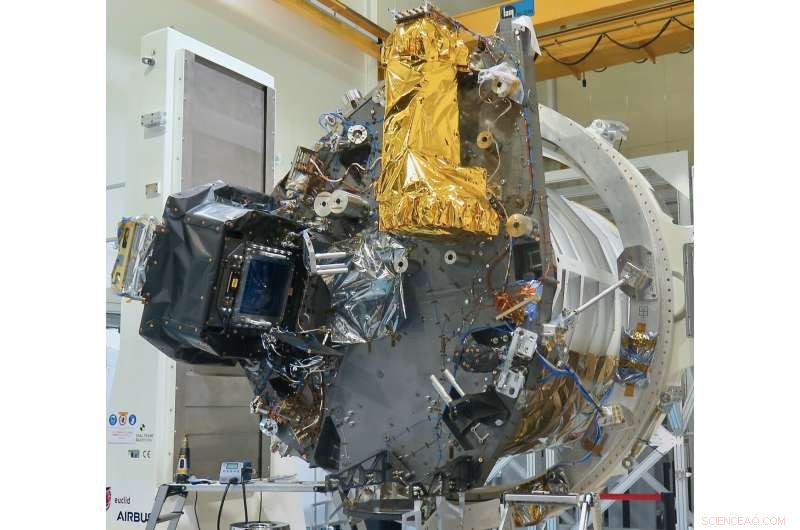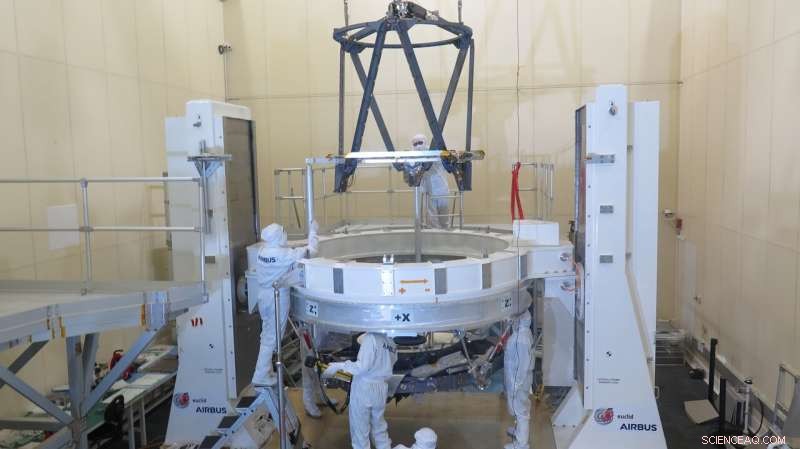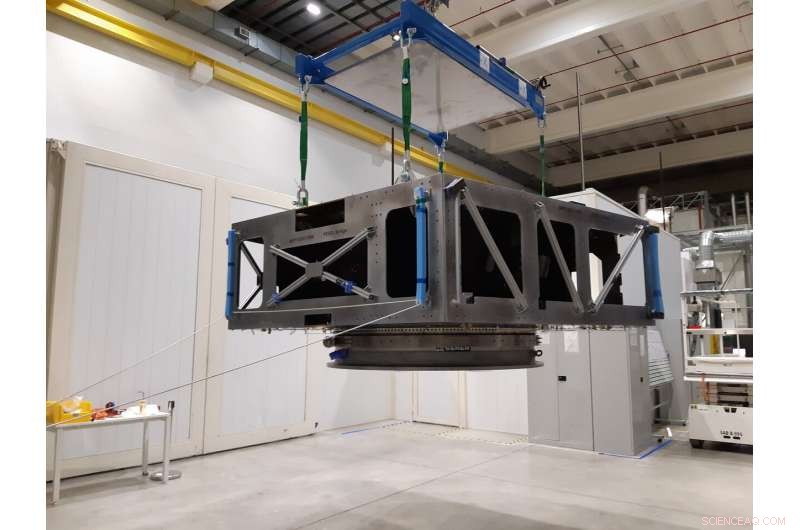
Los instrumentos VIS y NISP en el módulo de carga útil de Euclid. Crédito:Airbus
La misión Euclid de la ESA ha alcanzado otro hito en su camino hacia el lanzamiento. Sus dos instrumentos ahora están construidos y completamente probados. Estos se han entregado a Airbus Defence and Space en Toulouse, Francia, donde ahora se están integrando con el telescopio para formar el módulo de carga útil de la misión.
Euclid consiste en un telescopio de espejo de 1,2 metros que está diseñado para trabajar en longitudes de onda visibles e infrarrojas cercanas, siendo esta última un poco más larga que la luz roja que los humanos pueden ver. El telescopio recolectará luz de objetos cósmicos distantes y la alimentará a dos instrumentos.
El instrumento visible (VIS) y el espectrómetro y fotómetro de infrarrojo cercano (NISP) funcionarán en paralelo, registrando datos simultáneamente de cualquier parte del cielo a la que apunte el telescopio.
La misión de Euclides es medir las formas de más de mil millones de galaxias, y los desplazamientos al rojo precisos de decenas de millones de galaxias en más de un tercio del cielo. El corrimiento al rojo es un efecto causado por la expansión del Universo. Estira la longitud de onda de la luz emitida por galaxias distantes; cuanto más lejos está la galaxia, cuanto más extremo sea su corrimiento al rojo. Las galaxias en el estudio de Euclides abarcarán 10 mil millones de años de historia cósmica, y permitir que los científicos investiguen la misteriosa materia oscura y la energía oscura que se cree que dominan el Universo.
El instrumento VIS manejará la medición precisa de formas de galaxias tomando las mejores imágenes de galaxias distantes que pueda. Para hacer esto, el instrumento utiliza un mosaico de 36 CCD, cada uno de los cuales contiene 4000 píxeles por 4000 píxeles. Esto le da al detector un total de aproximadamente 600 megapíxeles.
"El diseño, desarrollo, fabricación, La prueba y calibración del instrumento VIS durante una docena de años con una especificación estricta ha sido un desafío, "dice Mark Cropper, Instrumento VIS líder y profesor en el Laboratorio de Ciencias Espaciales UCL Mullard, REINO UNIDO.
"Estamos inmensamente orgullosos de lo que el equipo de VIS ha logrado para llevar este proyecto a su culminación. Que el desempeño final supere nuestras expectativas es un tributo a su experiencia, dedicación y profesionalismo ".
No solo es impresionante la cantidad de píxeles, el instrumento también ofrecerá la mejor sensibilidad con poca luz en una amplia gama de longitudes de onda en tiempos de integración prolongados.
"Estos son CCD muy especiales, se han desarrollado específicamente para Euclid durante muchos años, "dice Alex Short, Ingeniero de carga útil VIS de la ESA.
El otro instrumento, NISP, se dedica a realizar mediciones espectroscópicas de galaxias, lo que implica dividir su luz en longitudes de onda individuales. Esto permite deducir los corrimientos al rojo. Esta propiedad permite a los cosmólogos estimar la distancia a la galaxia en cuestión, y permitirá que los datos de Euclides se conviertan en los más grandes, estudio tridimensional más preciso del Universo jamás realizado.
"El equipo internacional de NISP y las industrias de apoyo hicieron un trabajo increíble para diseñar, desarrollar y probar este desafiante instrumento, "dice Thierry Maciaszek, Gerente de proyectos de instrumentos NISP, del CNES y el Laboratoire d'Astrophysique de Marseille, Francia.
"Este es, sin embargo, no es el final de la historia para nosotros, ya que muchas actividades importantes deben completarse con NISP a nivel de satélite. Estamos esperando con impaciencia la primera luz en vuelo que demuestre el excelente desempeño global ".
El detector NISP contará con el campo de visión más grande jamás volado en el espacio para un instrumento infrarrojo.
"La calidad de la óptica es asombrosa, "dice Tobias Boenke, Mission System &NISP Instrument Engineer en la ESA.
Un factor clave para lograr la precisión óptica excepcional de Euclid fue la decisión tomada al principio de la historia del proyecto de construir todo el módulo de carga útil con carburo de silicio. El uso de este material en la ESA fue pionero en la fabricación del telescopio para la misión espacial Herschel. En la misión Gaia de la ESA, la estructura de soporte de los subsistemas de la nave espacial se montó sobre un marco de carburo de silicio. Sobre Euclides, el material se ha utilizado tanto para los instrumentos como para el telescopio.
Mientras que el metal se expande y contrae a medida que cambia la temperatura, degradando así la capacidad de un sistema óptico para enfocar la luz, El carburo de silicio es extremadamente estable a tales variaciones de temperatura. Pero el uso del compuesto conlleva sus propios desafíos. El carburo de silicio es una cerámica y mucho más frágil que el metal.

The supporting structure of the telescope’s secondary mirror for ESA’s Euclid spacecraft being brought together for final integration and optical alignment at Airbus in Toulouse, Francia. Crédito:Airbus
"It was a big challenge to be able to manufacture the instruments from this material and make sure they can remain undamaged during the launch, " adds Tobias.
Like VIS, NISP also uses specially designed state-of-the-art detectors to record the faint light coming from distant stars and galaxies. Unlike VIS, NISP can also operate in spectrographic mode. The detectors, which are operated at –180°C to provide ultra-low noise and high sensitivity, register these 'spectra' and convert them into tiny electronic signals. These signals can then be amplified and accurately measured to provide the photometric and spectroscopic redshifts.
The instruments will receive light from Euclid's telescope, which has already been assembled at Airbus, Toulouse. Like the instruments, it too is made from silicon carbide and is a state-of-the art construction in all senses.
"We are pushing all the manufacturing levels to the limit, " says Luis Miguel Gaspar Venancio, ESA's Mission Performance &Optical Systems Engineer.
A special component behind the telescope, called the dichroic, separates the collected light and diverts the visible wavelengths to VIS and the infrared wavelengths to NISP.
When the information from VIS and NISP is combined, scientists will be able to deduce the way that the Universe's large-scale distribution of galactic structures has built up throughout cosmic history. This will help them determine the speed at which such structures grow, providing strong constraints on the nature and amount of dark matter and dark energy in the Universe.
The instruments were prepared for delivery to Airbus just before the COVID-19 pandemic imposed restrictions and lockdowns in many ESA member states. Afortunadamente, VIS was already at Airbus, and NISP had to wait for a few weeks for shipment from Marseille to Toulouse, but was not on the critical path.
"I am extremely grateful to all project parties:institutes, industry and colleagues at ESA for their dedication and commitment during these difficult times, " says Giuseppe Racca, ESA's Euclid project manager.

The flight model of ESA’s Euclid mission’s service module being moved in the clean room at Thales Alenia Space in Torino, Italia. Credit:Thales Alenia Space Italy
"We were hit by the pandemic in a particularly critical moment when both VIS and NISP were to be transferred to industry. Despite the work and travel restrictions a concerted effort by all parties allowed to minimize the delays by implementing distributed and sequential integration activities of the instrument units and remote monitoring."
Now that the instruments have been delivered to Airbus, they will be integrated first with the telescope, and next with the rest of the payload module. It has been a long journey getting this far. Euclid was selected for implementation in 2011, having already undergone almost five years of studies. While there is still a lot of hard work and testing ahead, the delivery of the instruments and telescope means that the spacecraft can really begin to come together.
"Finalmente, we have something in front of our eyes, " says Luis Miguel. "It's not just paper anymore. It's a fantastic piece of hardware; beautiful in a way."
Integrating the payload module will last several months as it is painstaking work to get everything bolted together, precisely aligned and electronically talking. The instrument's control units have already been mechanically and electrically integrated to the payload module. These tests have verified that the instruments can be properly powered by the spacecraft, can talk to the onboard computers, and can transmit the science data that will then be downloaded to ground through the spacecraft antennas.
Once the telescope has been integrated with the rest of the payload module, it will be shipped to Centre Spatial de Liège, Bélgica, for 'end-to-end' testing in a thermal vacuum chamber that can simulate the conditions of space as well as possible on Earth. This test is scheduled to take place in February and March 2021.
Once that test shows that everything is working as expected, the payload module will be shipped to the prime contractor Thales Alenia Space (TAS), in Torino, Italia. TAS has been building the service module, which contains essential systems such as power, propulsion and communications.
The service module's main structure recently passed its structural and thermal tests and is now ready to have the various systems integrated inside. TAS will begin by laying down the pipelines for the propulsion systems, and the cabling for other distributed systems. Flight electronics, incluyendo computadoras, power units, and attitude control units, are already mounted on their own structural panels and these will now be installed inside the main structure. Integration is due to be complete in the third quarter of the year, at which time tests will be performed.
TAS will then integrate the payload module with the service module to form the final, finished spacecraft. Luego, another round of tests will ensure that everything is working together properly. En ese punto, the spacecraft is essentially finished, and ready for launch.
Launch is currently scheduled for the second half of 2022 from Europe's spaceport, Kourou, Guayana Francesa.